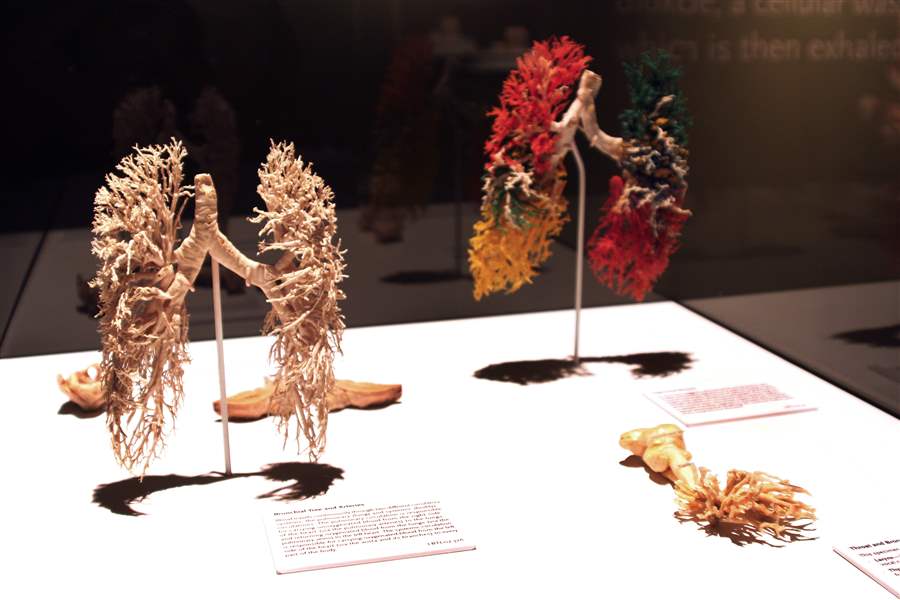
Bodies Revealed exhibit comes to Imagination Station
4/19/2011
All bodies and organ specimens in the exhibit were donated to accredited medical universities in China, where they were dissected and preserved.

Most people have seen a model of a human skeleton, heart, or another organ sometime in their life.
Get ready to see the real thing -- preserved bones, muscles, organs, and all -- at a temporary Imagination Station exhibit starting May 21.
The Bodies Revealed exhibit features 10 full bodies and more than 150 partial specimens that were dissected and hardened with a technique called polymer preservation, which uses liquid silicone rubber to preserve human tissue. A series of galleries will be enclosed in 6,000 square feet at Imagination Station to provide visitors with a detailed look at skeletal, muscular, reproductive, respiratory, circulatory, and other systems of the body, as well as how disease and unhealthy lifestyles affect them.
"Unless you're in medical school, you wouldn't have access to this kind of stuff," said Carl Nelson, chief scientist at Imagination Station. "It's amazing. It's something you have to see in person to experience it, to see how amazing your body is."
Said Lori Hauser, Imagination Station executive director: "We are thrilled to be able to bring this caliber of exhibit to northwest Ohio."
The exhibit that runs through Sept. 18 will cost Imagination Station about $300,000, but officials expect to recoup that amount through additional admissions on top of the science museum's usual ticket prices, said Dan Frick, a board member and interim chief financial officer.
"If it hits a grand slam home run and we make a little bit of money, that will be a side benefit," said Mr. Frick, adding the exhibit hopefully will increase Imagination Station membership and support.
Imagination Station is announcing the upcoming exhibit at a news conference Wednesday.
Tickets will go on sale about two weeks prior to the May 21 opening, and they may be sold on a timed basis, although members will be able to go at whatever time they want, officials said.
Audio tours will be available for a fee, and periodically speakers will talk on medical conditions.
The overall goal is to get people to take better care of their bodies, said Robert Savage, vice chairman of Imagination Station's board.

All bodies and organ specimens in the exhibit were donated to accredited medical universities in China, where they were dissected and preserved.
"Our job is to get people more excited about science," he said. "We think this is a very well put together exhibit to educate people about what their body looks like inside."
Organized by Premier Exhibitions Inc. of Atlanta, the exhibit in various versions has been shown in about 30 countries and attracted 15 million visitors since its first appearance in 2004.
All bodies and organ specimens in the exhibit were donated to accredited medical universities in China, where they were dissected and preserved.
The exhibit will give children and adults a better understanding of how their bodies work so they can make better choices concerning their health, said Roy Glover, chief medical director for Bodies Revealed.
He also is associate professor emeritus at the University of Michigan Medical School, where he developed the university's polymer preservation laboratory in 1989, taught anatomy, and did research.
Everyone will be able to relate to at least one medical condition, Mr. Glover said, adding that no one has ever fainted.
"This is a very personal exhibit," Mr. Glover said. "There are very, very personal kinds of things that people will experience when they come."
He added: "This is a very family friendly exhibit. It's not something that people should be afraid to bring their children to."
Ms. Hauser, the science center's executive director, said she has seen museum exhibits of polymer-preserved bodies elsewhere.
She distinctly remembers seeing a dissected leg from an obese human with layers of fat instead of muscle like in a average leg shown in comparison from one exhibit.
"You actually see what it looks like inside your leg," Ms. Hauser said. "I was like 'I'm going on a diet. I'm starting tomorrow.' "
Contact Julie M. McKinnon at: jmckinnon@theblade.com, or 419-724-6087.